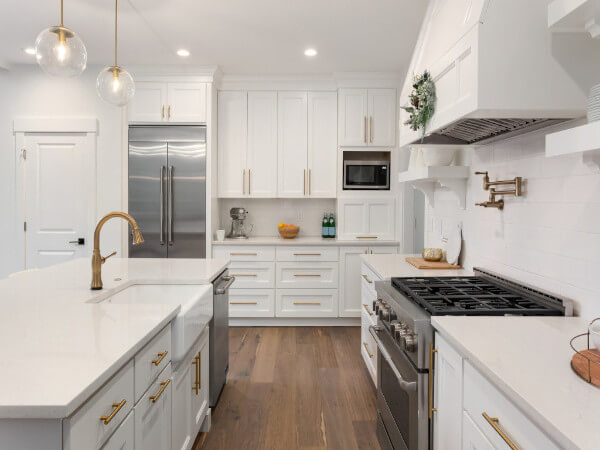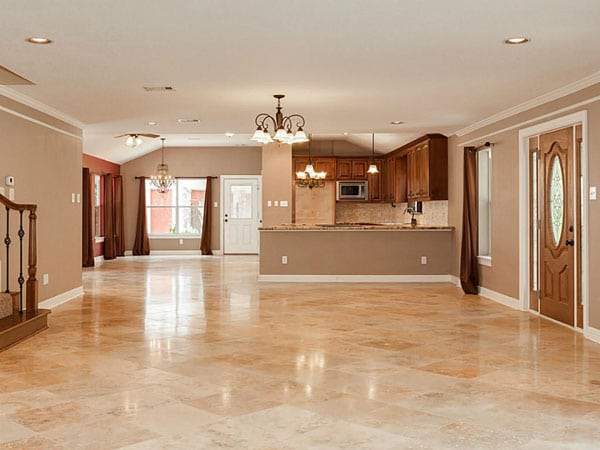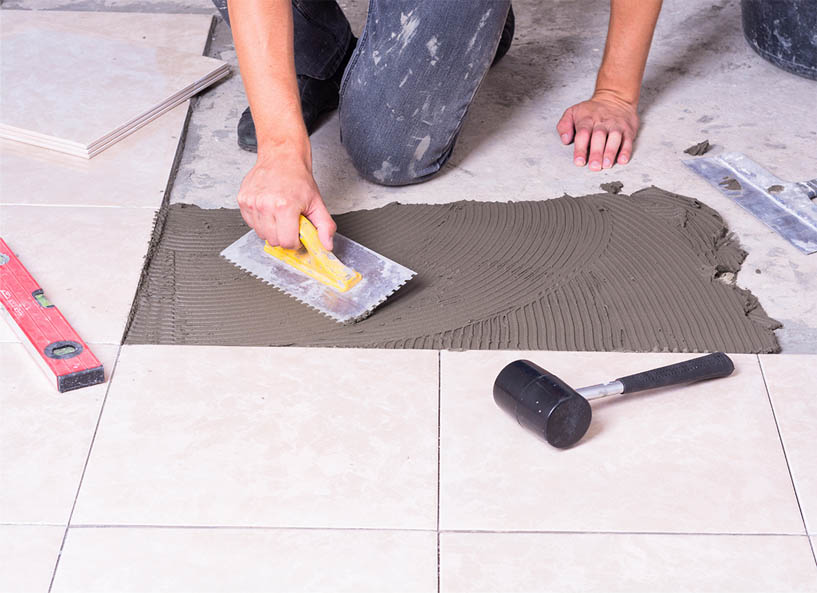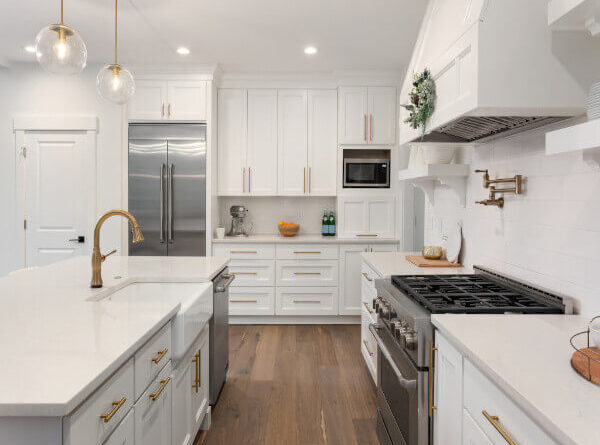Travertine Flooring Review: Pros and Cons
You want to add luxury and timeless beauty to your home, but you don’t have the budget for expensive marble or granite. Travertine is an affordable alternative that can give any room in your house a luxurious look with the durability of the stone. It’s perfect for kitchens, bathrooms, living rooms, and more.
And because it comes in so many different colors, you can easily find one that fits your style perfectly. While it is true that travertine has a timeless appeal, this natural stone does have some drawbacks. It’s not without flaws in terms of maintenance and installation. If you’re still interested in learning more about travertine flooring pros and cons, then keep reading.
What is Travertine Flooring?
Travertine is a natural stone that is deposited by geothermally heated hot springs. It’s considered a type of limestone that forms due to the rapid precipitation of calcium carbonate. Travertine comes in a variety of earth tone colors, including tans, browns, rust, and beige hues.

Image credit: https://kleanstone.com/
It’s a very durable stone and easier to care for than other natural stones. Plus, its heavy and porous surface requires you to seal the surface regularly. If you’re looking for a natural stone flooring solution that won’t break the bank, then travertine may be right up your alley.
This versatile material is available in dozens of beautiful shades, shapes, and sizes, so there are plenty of options to choose from when creating your custom design.
Pros and Cons of Travertine Tile
Natural stone is a material that can have both advantages and disadvantages. And travertine limestone falls under this category. As much as it has benefits, this stone also has some drawbacks.
Travertine Tile Pros
Travertine Flooring is Available in Various Designs and Color Schemes
One of the best advantages of travertine is the diversity of color schemes and designs it allows. Travertine flooring is available in a rich variety of colors, ranging from ivory to beige to gold and deep-reddish brown. This flooring material’s subtle color blends and its natural veining make it easy to create one-of-a-kind patterns and designs you’re looking for.
You can choose from its four different finishes, ranging from matte honed, tumbled, brushed, and polished. The most popular choice is the honed finish with a smooth and natural-looking while the rougher brushed, and tumbled finishes provide textural finishes.
Travertine is Environmentally-Friendly Flooring Material
Travertine is a natural stone that combines silica, calcium, and magnesium. You can add a healthy and environmentally-friendly touch to your home decor if you choose travertine flooring. In fact, the manufacturing technology of travertine requires less water usage and emits fewer greenhouse gases into the environment.
This process also creates minimal waste in landfills or does not cause harmful air or water pollution. The use of limestone also dates to ancient architecture in Rome when they would use Aqua Traiana, a pure water source, to create the smooth white-colored marble stones. It’s more eco-friendly than laminates. Natural stone tile can also be reused or repurposed.
Travertine is Durable and can Last Long if Properly Maintained
Travertine tiles are very durable; these durable stones are both water and moisture-resistant. All you need to do is to give them proper care. They won’t crack easily if you handle them with care, enabling you to keep the good condition of your home for long years.
Travertine adds another value: your house will look new, courtesy of the travertine tiles. Travertine floors, countertops, and pavers are very robust and can easily survive the test of time. When you look at some of the ancient places where travertine was used, you’ll see how this natural stone has stood the taste of time by lasting for a very long time.
The hardness rating of flooring travertine is compared to that of marble flooring, so it’s suitable for heavy foot traffic areas. Since this material is a natural stone, it might have holes in it. These holes might get bigger and deeper in time, thus ruining your flooring. Make sure you give your travertine flooring proper care for it to last long.
Having ceramic tiles or granite in your kitchen and luxury vinyl in your bathroom may look nice, but travertine floor throughout your home can increase its value. Travertine can outlast other natural stones as long as you maintain it.
Travertine Tiles are Resilient
These tiles can tolerate extreme weather fluctuations, thus making them suited for both indoor and outdoor installations. You can install travertine pavers for your garden pathway, pool, and retaining wall of your house without worrying about the scorching heat that can damage your travertine.
It Has a Naturally Non-Slippery Texture
The non-slippery nature of travertine makes it suitable for installation in swimming pools, bathrooms, showers, flowers, and on pool decks. It has holes and pits due to its porous surface, making it rough and not slippery in an unsealed and unpolished state.
Replacing Travertine Tile is Quite Easy
Even though flooring material is durable, accidents can still happen after a few years of use. This way, it can get damaged or ruined. However, you don’t need to fret if you have damaged travertine. With several travertine variations, it’s possible to find not the same but the one similar to travertine stone.
You can replace travertine tiles with new ones with matching tones or colors. In fact, no one would be able to notice the difference. You can also invest in a few travertine tiles just in case your tile gets damaged.
The Color Variation in Travertine Makes Each Tile Unique and Beautiful
The natural colors of travertine stone range from grey veining to rusty red with white veins and light brownish tones with cream, beige and orange tones. A single tile may have a layer upon layer of pastel colors and various patterns like stripes and veins.
Cons of Travertine Tile Flooring
It Can Get Damaged from Weather and Sun Exposure
Travertine is a very soft stone. It tends to wear away over time and can easily get damaged by weather and sun exposure. You need to be careful while using chemicals for cleaning purposes because they might corrode the calcium deposits in the tile, which will give out discolorations.
You should avoid using travertine in your garden or on your back patio because it doesn’t hold well outdoors under constant moisture conditions.
Travertine is a Porous Material
Travertine is a porous material, meaning it will need to be sealed. Make sure you seal your travertine with a high-quality sealer before grouting it. This will prevent the grout from seeping into the surface and causing discoloration or colored dyes to appear on your floor.
Failure to seal may attract mildew after experiencing some staining. You also need to consider how often your travertine is exposed to moisture and cleaning products before sealing.
Travertine Tiles are Highly Reactive to Acidic Substance
A major disadvantage of this flooring material is the sensitivity towards acidic substances such as alcohol, vinegar, coffee, and orange juice. Suppose you accidentally spill orange or lemon juice on the travertine tiles. In that case, you risk having a permanent stain because the acidic solvent will react with the calcium carbonate of the stone.
So, be careful while using these tiles, especially if you have small kids around. Also, give it a second thought before using travertine tile to decorate your restaurant and kitchen countertops.
Travertine Tiles Tend to be Heavier
If you’re looking for an easy and quick installation process, travertine tiles might not be the right option for you. These tiles naturally tend to be heavy. Therefore, it would be difficult and time-consuming to install them. You should also be concerned about the transportation of these tiles from the store you buy them to your house. Their transportation cost might be a bit more expensive than other flooring materials.
Travertine Requires Maintenance and Care
This tile might be considered durable and resilient but doesn’t mean that it doesn’t require extensive maintenance. Unlike how you mob your flooring options such as granite, ceramic tile, porcelain tile, and vinyl, travertine requires much attention. This attention is what gives it the beauty and everlasting sense of elegance.
If unsealed and unpolished, this material is susceptible to damage because of the fear of its porous structure that absorbs spills in its holes and pits. That’s why it’s important to seal your tile to prolong its life. It’s recommended to use a penetrating sealer, especially when pets are active around food preparation surfaces.
Travertine is Only Available in Neutral Tones
Travertine is a type of limestone, and limestone is naturally white. That means that you cannot find travertine in bright or funky colors. Its tones and shades are limited to beige, white, cream, and tans. It’s also light in color because of the white calcium carbonate.
You can’t find travertine in any colors and shades apart from the neutral and earthy tones. If you’re looking for brighter colors, opt for other materials such as marble, granite, and slate.
Travertine Tile Finishes
Polished Travertine Tile
Polished stone is commonly available in a polished finish. Polished travertine tiles make the stone look shiny and glossy, like a mirror. A surface of polished tiles traps small particles of dirt, making it difficult for you to clean.

Image credit: https://cdn.shopify.com/
Honed Travertine Tile
This travertine tile is matte polished tile and is used mostly in flooring. It looks like classic travertine tile, but it’s not shiny or glossy.
Tumbled Travertine Tile
Tumbled travertine tiles have a textured and matte look. Tumbled travertine has a more antiqued appearance, making it a darling to indoor decorations. Tumbled tiles are also used in bathrooms and near pool decks because of the non-slippery surface.
Brushed Travertine Tile
This is a finish travertine tile shared with engineered and hardwood flooring. While it’s not hand-scraped, these tiles are finished in a fashion that leaves the surface rougher than other finishes.
Travertine vs. Porcelain Tiles
Many porcelain tiles today do a good job of mimicking natural stone, including travertine. The appearance of travertine-porcelain is not exactly like natural stone, but it’s close to the look of polished and honed travertine. Stone-look porcelain is less expensive as the average can cost $7 to $10 per square foot for professional installation, but it can be half price if you install it yourself.
Travertine Flooring Installation
Like other natural stones, you can install travertine tile the same way as ceramic tile. Apply a layer of cement board underlayment on the subfloor, then lay the stone tiles with a thin-set adhesive. And lastly, fill the joints with grout, and you’re done.

Image credit: https://cdn.msisurfaces.com/
FAQs on Travertine Flooring Review
Is travertine a good choice for flooring?
Yes, travertine is a good choice for flooring because it’s durable and luxurious compared to other floor materials such as marble and granite.
re travertine floors outdated?
The travertine floor is not outdated, even though many people believe so. These flooring materials are increasingly used in construction projects, thanks to their durability and long-lasting beauty.
Final Thought on Travertine Flooring Review: Pros and Cons
That’s all! If you’re looking for a natural stone that can add some coziness and beauty to your floors, then travertine tile is the ideal choice. But if you want a low-maintenance floor surface, then try other materials, especially if you have small kids and pets around.
The post Travertine Flooring Review: Pros and Cons appeared first on Kitchen Infinity.
Did you miss our previous article…
https://public-kitchen.org/?p=338


